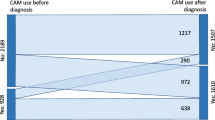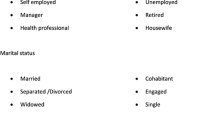Abstract
Background
Patients suffering from cancer often make use of complementary and alternative medicine (CAM). Only few data exist on the prevalence and clinical significance of interactions of a biological CAM method and conventional drugs.
Methods
From February 2014 to March 2016, consecutive patients from five oncological practices in Germany were asked to fulfill a standardized questionnaire regarding use of CAM. Data on diagnosis, date of first diagnosis, ECOG and the past and current treatment were derived from the patients’ files. Interactions were evaluated by systematically using a database on potential interactions.
Results
From 1000 patients asked to participate, we received a total of 720 questionnaires of which 711 were completed and eligible for evaluation. 29% of the patients reported any CAM usage. Women showed a significantly higher use of CAM with 35.6 versus 23.6% of men. For 54.9% of CAM users (15.9% of all patients), we found a combination of conventional drugs and biological based CAM methods with a risk for interactions. Vitamins A, C and E were the most frequently used CAM substances in these cases (39.3%), followed by herbs with 17.5%.
Conclusion
There was a risk of interactions between a biological CAM method and conventional drugs in 54.9% of the patients using CAM. To raise knowledge on interactions a better training for doctors with respect to CAM is strongly needed. Furthermore, patients’ awareness should also be raised and communication between physician and patient on the topic improved.


Similar content being viewed by others
References
Berretta M, Della Pepa C, Tralongo P, Fulvi A, Martellotta F, Lleshi A et al (2016) Use of complementary and alternative medicine (CAM) in cancer patients: an Italian multicenter survey. Oncotarget 8(15):24401–24414
Cassileth BR, Lucarelli CD (2003) Herb–drug interactions in oncology. BC Decker, Inc, Hamilton
Complementary, Alternative, or Integrative Health: What’s In a Name? | NCCIH (2016) National center for complementary and integrative health. https://nccih.nih.gov/health/integrative-health. Accessed 30 Nov 2017
Drug Information—Express Scripts® (2018) https://www.express-scripts.com/medco/consumer/ehealth/druginfo/dlmain.jsp?WC=N. Accessed 5 Jan 2018
Hillen MA, de Haes HCJM., Stalpers LJA, Klinkenbijl JHG, Eddes EH, Butow PN et al (2014) How can communication by oncologists enhance patients’ trust? An experimental study. Ann Oncol 25(4):896–901
Horneber M, Bueschel G, Dennert G, Less D, Ritter E, Zwahlen M (2012) How many cancer patients use complementary and alternative medicine: a systematic review and metaanalysis. Integr Cancer Ther 11(3):187–203
Huebner J, Muenstedt K, Muecke R, Micke O, Stoll C, Kleeberg UR et al (2013) Counseling cancer patients on complementary and alternative medicine: background, theory, and implementation of nationwide counseling facilities. Strahlenther Onkol 189(8):613–617
Huebner J, Muenstedt K, Prott FJ, Stoll C, Micke O, Buentzel J et al (2014a) Online survey of patients with breast cancer on complementary and alternative medicine. Breast Care (Basel Switzerland) 9(1):60–63
Huebner J, Micke O, Muecke R, Buentzel J, Prott FJ, Kleeberg U et al (2014b) User rate of complementary and alternative medicine (CAM) of patients visiting a counseling facility for CAM of a German comprehensive cancer center. Anticancer Res 34(2):943–948
Integrative Medicine: Search About Herbs | Memorial Sloan Kettering Cancer Center (2018) https://www.mskcc.org/cancer-care/diagnosis-treatment/symptom-management/integrative-medicine/herbs/search. Accessed 5 Jan 2018
Loquai C, Dechent D, Garzarolli M, Kaatz M, Kaehler KC, Kurschat P et al (2016) Risk of interactions between complementary and alternative medicine and medication for comorbidities in patients with melanoma. Med Oncol 33(5):52
Loquai C, Schmidtmann I, Garzarolli M, Kaatz M, Kahler KC, Kurschat P et al (2017) Interactions from complementary and alternative medicine in patients with melanoma. Melanoma Res 27(3):238–242
Meijerman I, Beijnen JH, Schellens JHM (2006) Herb-drug interactions in oncology: focus on mechanisms of induction. Oncologist 11(7):742–752
Pourroy B, Letellier C, Helvig A, Chanet B, De Crozals F, Alessandra C (2017). Development of a rapid risk evaluation tool for herbs/drugs interactions in cancer patients: a multicentric experience in south of France. Eur J Cancer Care 26(6):e12752
Robinson A, McGrail MR (2004) Disclosure of CAM use to medical practitioners: a review of qualitative and quantitative studies. Complement Ther Med. https://doi.org/10.1016/j.ctim.2004.09.006
Saxe GA, Madlensky L, Kealey S, Wu DPH, Freeman KL, Pierce JP (2008) Disclosure to physicians of CAM use by breast cancer patients: findings from the Women’s Healthy Eating and Living Study. Integr Cancer Ther 7(3):122–129
Wortmann JK, Bremer A, Eich H, Wortmann HK, Schuster A, Fühner J et al (2016) Use of complementary and alternative medicine by patients with cancer: a cross-sectional study at different points of cancer care. Med Oncol 33(7):78
Zeller T, Muenstedt K, Stoll C, Schweder J, Senf B, Ruckhaeberle E et al (2013) Potential interactions of complementary and alternative medicine with cancer therapy in outpatients with gynecological cancer in a comprehensive cancer center. J Cancer Res Clin Oncol 139(3):357–365
Funding
There was no funding for this review and study.
Author information
Authors and Affiliations
Corresponding author
Ethics declarations
Conflict of interest
The author declares that they have no conflict of interest.
Ethical approval
All procedures performed in studies involving human participants were in accordance with the ethical standards of the institutional and/or national research committee and with the 1964 Helsinki declaration and its later amendments or comparable ethical standards.
Informed consent
Informed consent was obtained from all individual participants included in the study.
Rights and permissions
About this article
Cite this article
Firkins, R., Eisfeld, H., Keinki, C. et al. The use of complementary and alternative medicine by patients in routine care and the risk of interactions. J Cancer Res Clin Oncol 144, 551–557 (2018). https://doi.org/10.1007/s00432-018-2587-7
Received:
Accepted:
Published:
Issue Date:
DOI: https://doi.org/10.1007/s00432-018-2587-7




